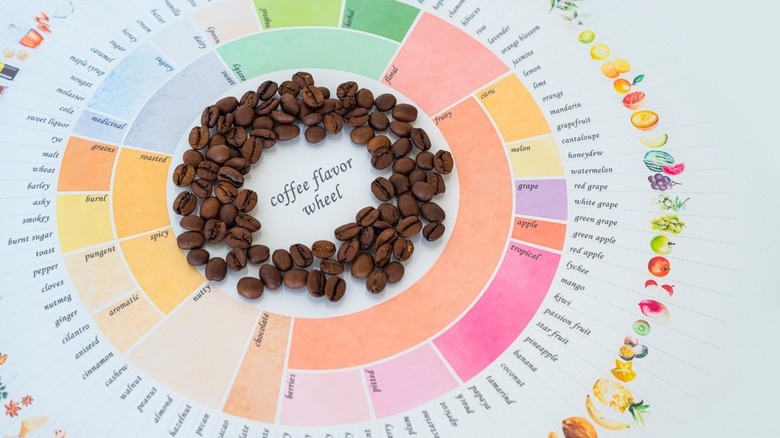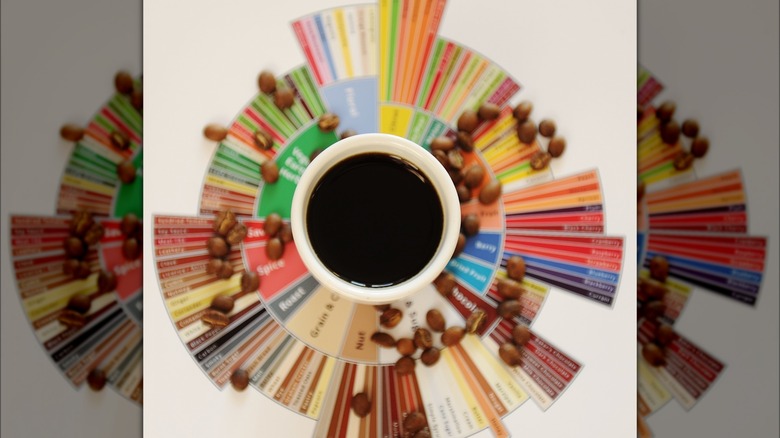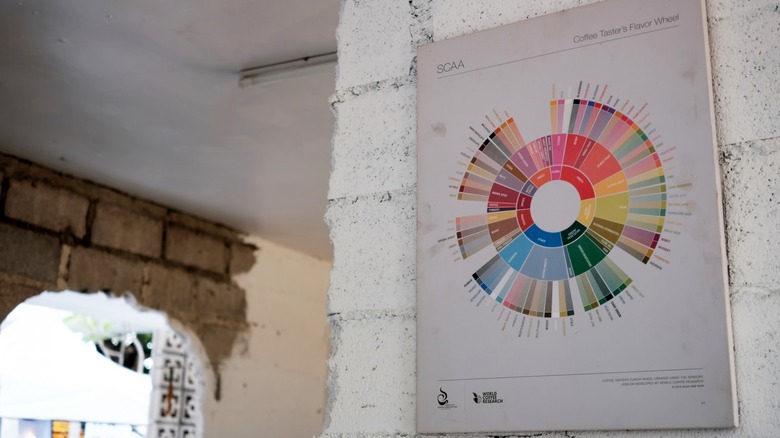What Is A Coffee Flavor Wheel And How Do You Use One?
Any wine sommelier or chef will tell you pinning down tastes can sometimes be arduous. As a result, most foodies, home cooks, and some experts often rely on online tutorials or guidebooks like "The Flavor Matrix," written by The Institute of Culinary Education's Chef-Instructor James Briscione (which is an excellent reference tool), to figure out complementary flavor pairings. Still, while most are aware of such scientifically focused authoritative guides regarding food and wine, few know that coffee also has a reference aid meant to assist consumers while discovering all the hidden notes inside their favorite morning brew: The coffee flavor wheel.
Initially published in 1995, World Coffee Research created the "Coffee Taster's Flavor Wheel," but it was updated by its collaborative efforts with the Specialty Coffee Association in 2016. Both institutions' work on this research became what is known as the World Coffee Research Sensory Lexicon, a study concentrated on recognizing the "110 flavor, aroma, and texture attributes present in coffee."
The reason for doing so, as World Coffee Research explains on its website, was to construct a tool that would help researchers probe coffee specimens "in conjunction with chemical and genetic analysis in order to understand the origins of coffee quality." As a result, the (coffee) wheel was born, which is a win for everyone. The only question is, how do you use it?
How to use the Coffee Taster's Flavor Wheel
According to the Speciality Coffee Association (SCA), its flavor wheel is available for purchase as an educational asset that industry professionals have used for over 20 years. Still, other experts, like the CEO of CoffeeMind Morten Münchow, told newGround that they are looking to make their own because of some apparent issues with the current model.
"The first challenge is mapping the descriptors," Münchow stated. "It has to be enough so people can feel they represent all the coffees that they would ever experience, but also not include so many that it makes things chaotic."
Münchow cites another issue with determining the flavors. "With the SCA wheel, we can tell that they tried to create a pattern. But it is almost impossible to establish one because of the many different cultural aspects that relate to tasting around the world."
Incidentally, Münchow has a point; glancing at the SCA's wheel takes a minute to decipher. As a result, coffee purveyors like Bridge Coffee Roasters have offered a YouTube video to help. According to the company, "Every coffee in the world is somewhere on this map." Still, more importantly, Bridge Coffee Roasters explain that you need to start with the inside-center ring. Identify the closest identifiable flavor and trace its nuances into the second and third rings until you can determine the flavor note.
Things of note when using the SCA's coffee wheel
The SCA provides its own instructions on how to use its Coffee Taster's Flavor Wheel on the organization's website. Although it doesn't differ much from other educational guides, the organization offers some suggestions.
For starters, SCA recommends drinking a cup as you follow the wheel to a possible profile, which is probably the best suggestion you'll ever get. After all, taste is strongly related to what people eat and smell. So, having the brew in front of you will help the process since you can pick up on any accents and aromatics.
However, SCA's most significant contribution to working out how to decode its flavor wheel is explaining what the lined cells between the second and third rings are. According to the institution, the lines leading up to categorizing each tasting note may be sectioned off from one another or placed side by side. This is because, during both organizations' analyses, some contributing researchers felt that some flavor profiles were firmly connected. As a result, notes like grapefruit or orange may be interchangeable and still considered accurate, which is interesting since both citruses have distinct flavors despite being relatives. Either way, no matter what taste profiles you obtain on your own while sipping on a great cup of coffee, a flavor wheel might become a new best friend when it comes time to describe all those little nuances typically left on the tip of your tongue.


